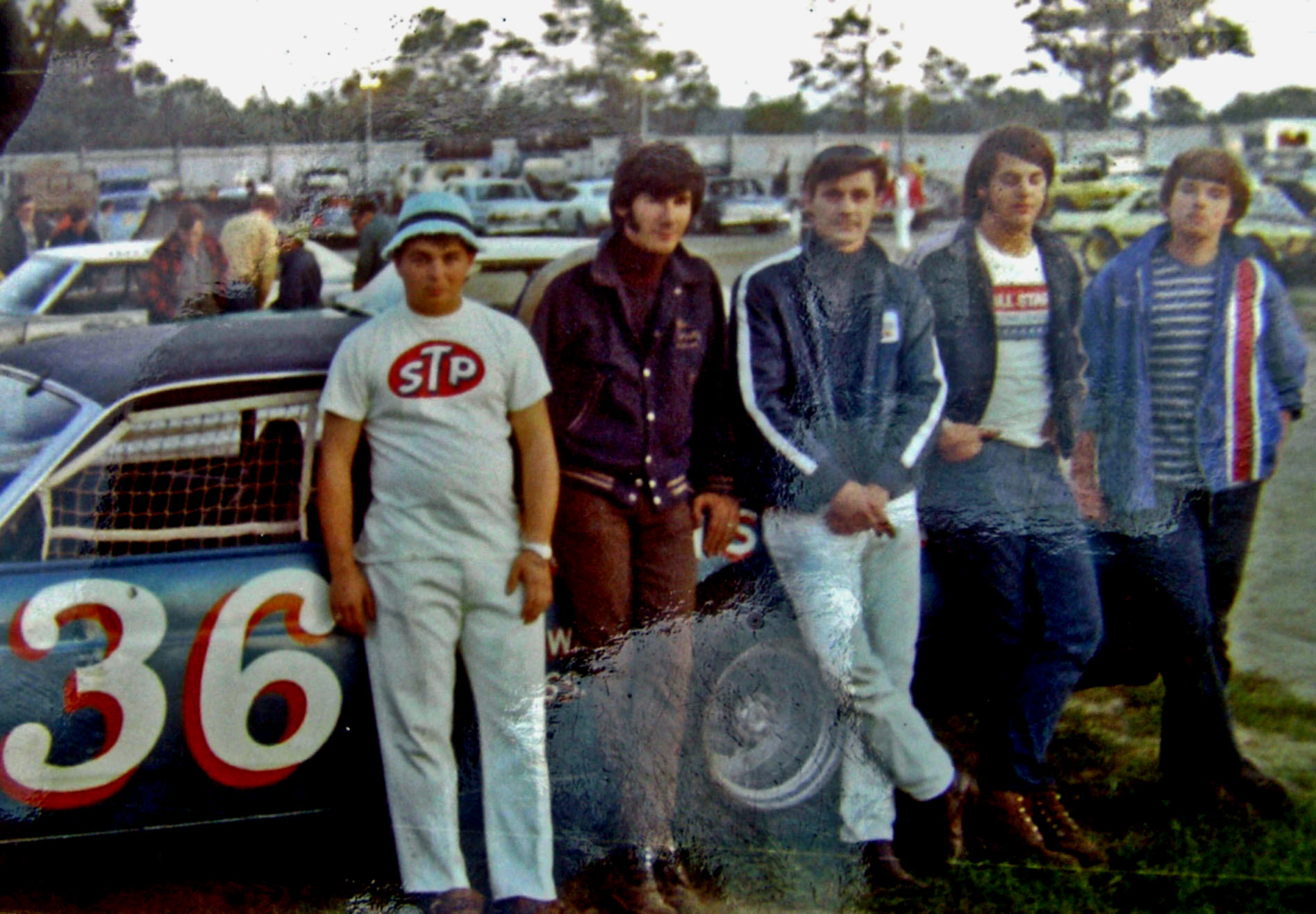
Courtesy of Cho Lee
Another shot from the first
season shows the Rosati teenage brain trust which includes Steve
McKnight, at far right. Several crew members had to get parental
consent to serve on the team and travel. Below - Tom Rosati, with his
Oxford 250 – winning car [with my E. A. Grandfield ad on side :)]
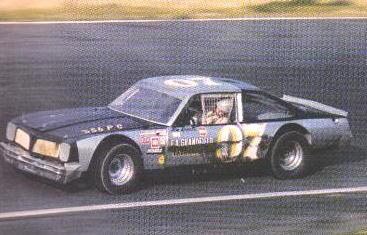
Courtesy of Andy Boright
The
Rosati Ford team basically used one car and usually kept the other in
reserve, the one exception being a big race at Catamount where Steady
Eddie Flemke drive the second car. The team ran for about three
seasons, at one point selling one of the Fairlanes to the wild,
unpredictable Robert E. “Bucky” Dragon, of Ripton, VT, who used it [as
a battering ram most of the time] to run in a late model class at
Devil's Bowl Speedway around 1975 or 6, whenever C. J. went back to
dirt. The other car was eventually sold to Dale “Tubby” Hatch, a
former Thunder Road flathead driver from Groton, VT.
One
of the factors that made the young John Rosati such a hit was The Mod
Squad. Made up of teenaged Robbie Crouch, fresh out of Florida,
Sharon, Massachusetts' Joey Kourafas, and Rosati, the long – haired
Mod Squad members drove the girls wild, and many young area boys
wanted to be just like them. All three were good drivers right away;
and – although Kourafas would go on to win the first Oxford 250 series
race and Crouch would become the circuit's winningest driver – John
Rosati was the first to be successful, winning the 1971 Rookie of the
Year award. His top notch equipment made that early difference, in my
opinion.
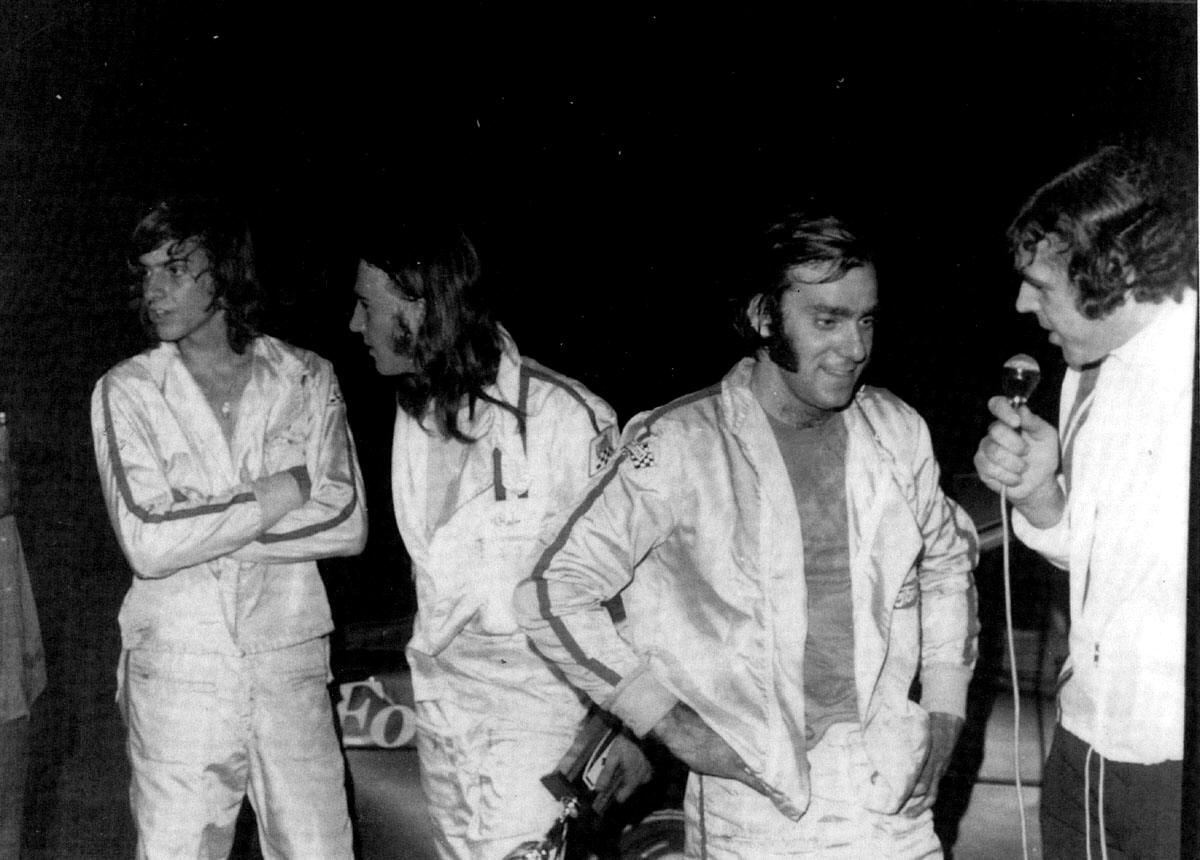
Courtesy of Cho Lee
The Mod Squad: John Rosati
interviews with Peter B. Guibard while Crouch and Kourafas keep a wary
eye out for attacking screaming girls.
Below – A favorite of mine shows the John Rosati's with young Tommy on
the go kart.
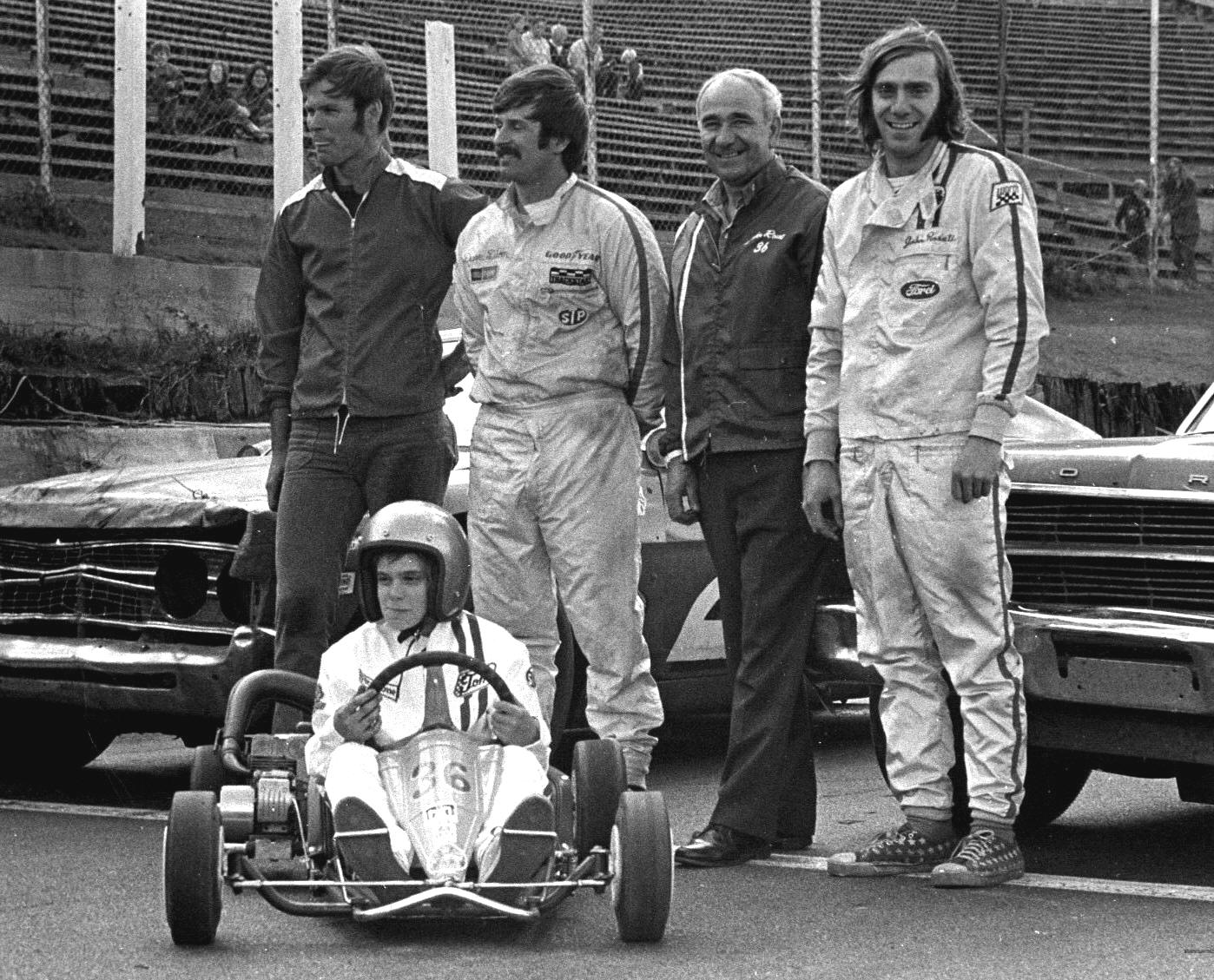
Ladabouche Collection
The
Rosatis would go on to support the racing efforts of the younger
brother, Tommie Rosati, who campaigned a Pontiac Ventura with a very
conservative budget later on the 1970's. Tom would go on to win one of
the Oxford 250's [carrying an ad I had lettered for him for E.A.
Grandfield Excavating] I believe it was the only Oxford 250 winner I
ever had any sign work on. When John went back to Massachusetts and
took up modified racing, he was on his own. The same with any further
racing enterprises for the younger Rosati.
The
Rosatis were friendly, popular additions to the racing scene up our
way. Big John was a wonderful man, and so was Little John [if not a
bit on the quiet side]. The more gregarious Tom had a big following
for his brief stay with Northern NASCAR. Ford fans would still have
the dynamic Dave Dion to root for; but the Rosatis had a certain flair
of their own, riding the wave of Massachusetts invaders – mostly from
Norwood Arena – in 1971 through 1975. They were sorely missed when all
had returned to Agawam for good.

Shaney Lorenzet Photo
The last year of the Rosati
northern experience. Below – The Rosati's Agawam neighbor needed no
introduction when he arrived in 1972.

All Star League Program Photo
The
second myth also centered around Agawam, MA. You had to be dead or no
race fan at all if you didn't know who Rene Charland was by 1972. A
Holyoke, MA native and an ex – Marine, Charland had won his first race
at the old Brattleboro Speedway in West Brattleboro, VT in 1951. After
a few more years of running in local races from northern
Massachusetts, to southern Vermont, to the Keene, NH area, Charland
had observed the way northern New Yorkers had won NASCAR National
Sportsman championships and – allied with talented car builder Fred
Rosner and ace mechanics like Godfrey Wenzel, he had set about to the
1962 title, himself. He ended up winning four in a row, often
outdistancing his nearest competitor by hundreds of points.
Charland was, for whatever reason, no longer chasing national titles.
It was, after all, an unbelievably grueling prospect, as Dick Nephew
once told me. An incredible prankster with a past at Thunder Road,
Charland was more welcomed back by some people than others. The high –
banked quarter mile was never particularly kind to The Champ, once
dumping him on his roof in a Milk Bowl in the George Hay 68, a
flathead coupe he campaigned for NASCAR points in 1965. When the
Northern NASCAR circuit for late model sportsman cars was designed in
1971, it drew a number of Bay State drivers. It surprised more than a
few people that one of those drivers was Charland, who had never shown
much propensity for late model cars.

Courtesy of 176 Racing.Com
Rene Charland's first brush
with the Nation's Site of Excitement came in one of the Milk Bowls. He
didn't win this one ,
but he apparently won a Governor's Cup. Below – Rene's first arrival
with the yellow version of the Chevelle – the Jay-Lin car.
Naturally they pitted next to the Rosatis, Agawam neighbors.
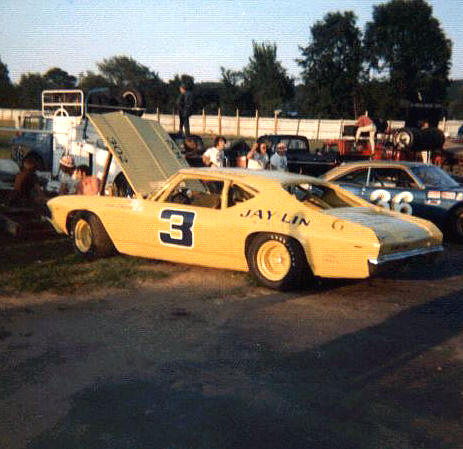
Ladabouche Photo
In 1971,
as Catamount was hosting its annual pre – season practice session,
Charland showed up with a 1968 Chevelle, done up in the familiar
yellow color scheme of Jay – Lin, under Jay Broderick's racing
suppport. Broderick, recently deceased, supported cars for Charland,
Don Wayman, others, and most notably his son, Jimmy. Charland, with a
professionally – constructed late model and all of that experience,
looked to be a shoo – in for big success on a circuit, the majority of
whose participants lacked much of any seat time in a full – powered
late model sportsman.
With
Charland not necessarily being universally loved on the circuit and
with his T Road curse the way it was, it surprised few people when he
was photographed flying through the air, launched by that wicked,
slanting retaining wall, landing on the lawn between the wall and the
retaining fence. That ride, which didn't hurt Charland at all [or did
too much to the Chevelle] was universally remembered and chuckled at
by a lot of fans. It is not clear how he got launched up there – Stub
Fadden was the closest car behind him, and Stubby was not known for a
lot of roughness.
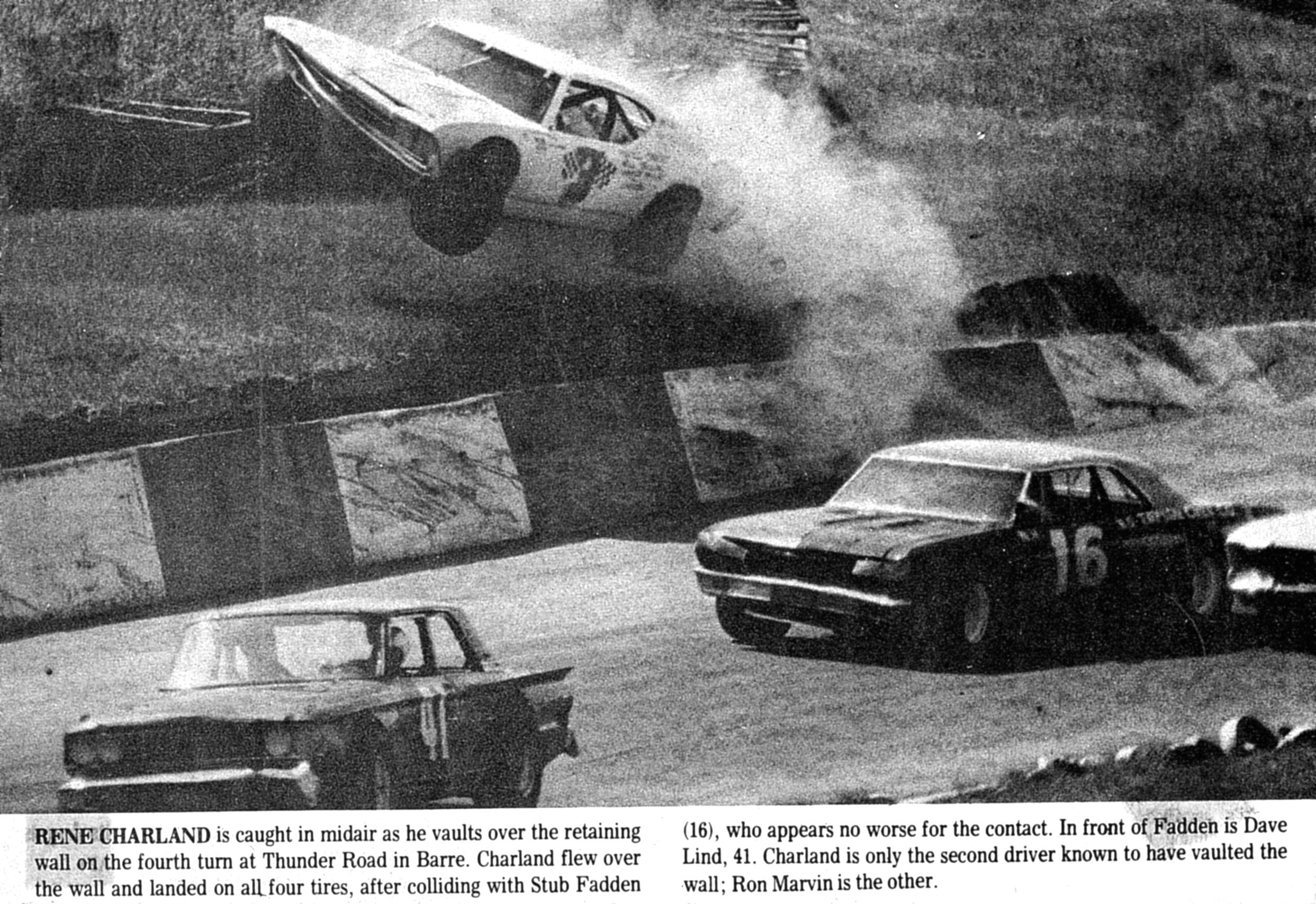
Free Press Photo Ladabouche
Collection
Charland vaults the wall for
the first time with the white Chevelle. Below - He appears to
have a few choices words for
Bob Quinn as he leaves his car on the lawn above the flag stand. He
could off the clown act just as fast as he turned it on.
Courtesy of Cho Lee
What many people don't
know is that Charland [already distinguished in joining Ronnie Marvin
and Rex Shattuck some of the as the only drivers to accomplish the
lawn landing] went on to accomplish it all again that same season !
Most of us assumed all those shots were from one accident. Not so. A
second, much less famous photo, shows him again flying up the
widowmaker. The photo is very grainy, but it appears as though the car
must have been in some stages of body repair as it seems to have no
numbers on the door. There is a shot of Charland walking away from the
first crash, giving an earful to starter Bob Quinn on the way back to
the pits [which, no doubt, was full of guys some of whom were actually
trying to hide their grins].
Rene Charland would run the Chevelle for two years – the first as the
yellow 3MA, and the second with the car in white. It was in that
second season, 1972, where he enjoyed the rides up the widowmaker.
Rene had many more seasons left – most of which he ran on dirt. His
most lasting ride seemed to be the Roehrig brothers' gold #99 Gremlin,
out of Round Lake, NY. He returned to Catamount to run in the All Star
Stock Car Racing League shows; as he was a loyal supporter of that
series and very good at it. However, two trips up the wall at Thunder
Road had largely satisfied any urge Da Champ had to run late models
ever again.
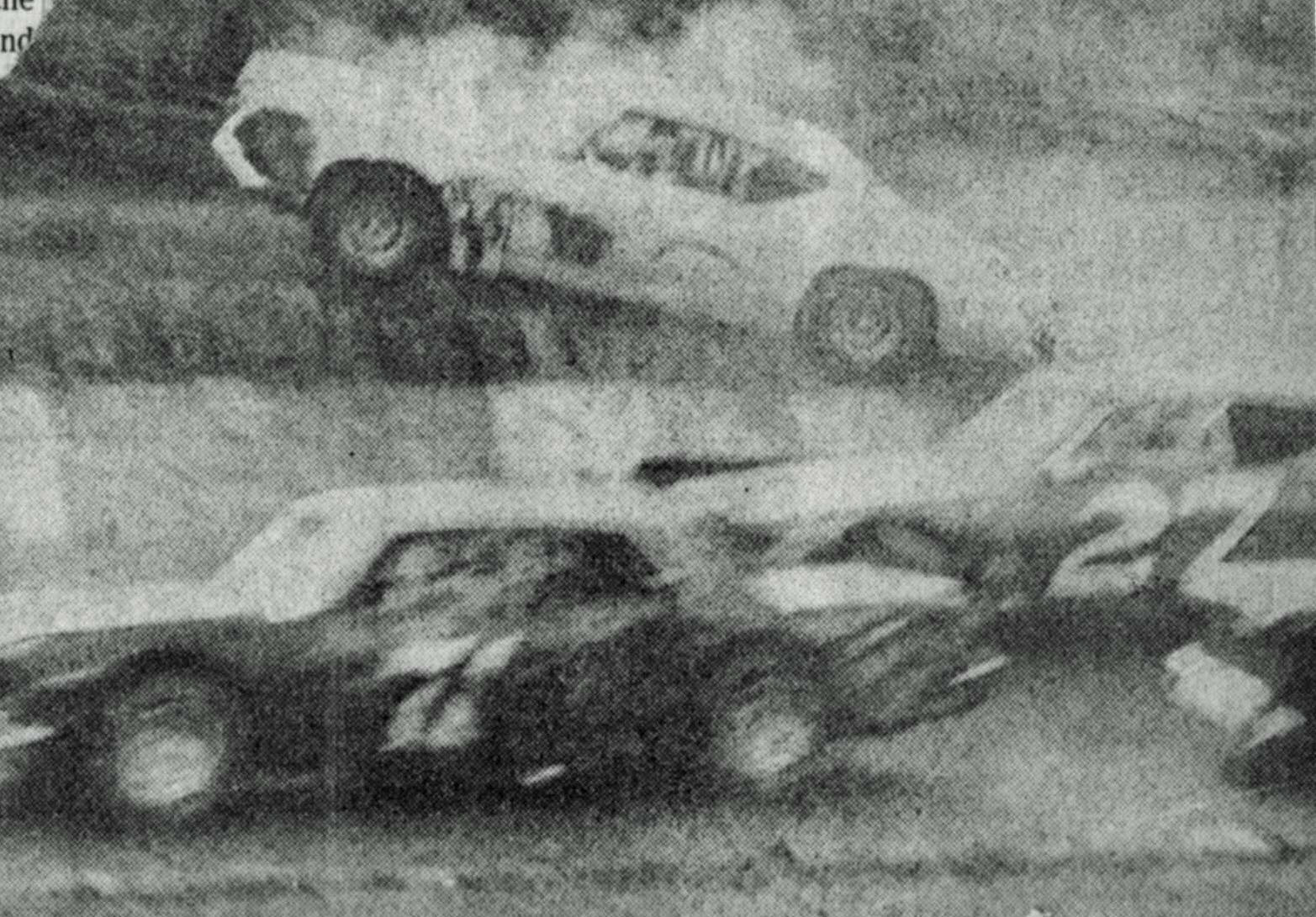
Free Press Photo Courtesy of
Wayne Bettis
Charland does an encore with
that poor Chevelle later on in the season. Below – The Chevelle looks
much
the worse for wear as it rolls into the pits at the hated Thunder
Road.

Courtesy of Andy Boright
The
third and next myth centers around the great Canadian driver, Jean –
Paul Cabana, who was a principal rival of Charland's in those years in
the 1960's when northeastern and Quebec teams led the way in chasing
NASCAR national points. A young Jean – Paul first appeared in races
near his home, knowing full well he was forbidden to race by his
father. When he appeared in some post – race event on the track in
front of the stands, who was in the front row ? None other than Pere
Cabana. He would get the most early experience racing at the majestic
old horse track, Bouvrette Speedway in St. Jerome.
Cabana began to gather a corps of dependable people around him,
particularly mechanic [mecanicien] Claude Faniau, who stayed with Jean
– Paul for decades. Cabana began to be prominent in the NASCAR
sportsman ranks, racing locally at Riverside Speedway, Laval and other
tracks such as Fury Speedway. He would begin to venture down into the
states, even so far as Fonda Speedway. It was then that his trademark
number, 5A, was beginning to be seen.
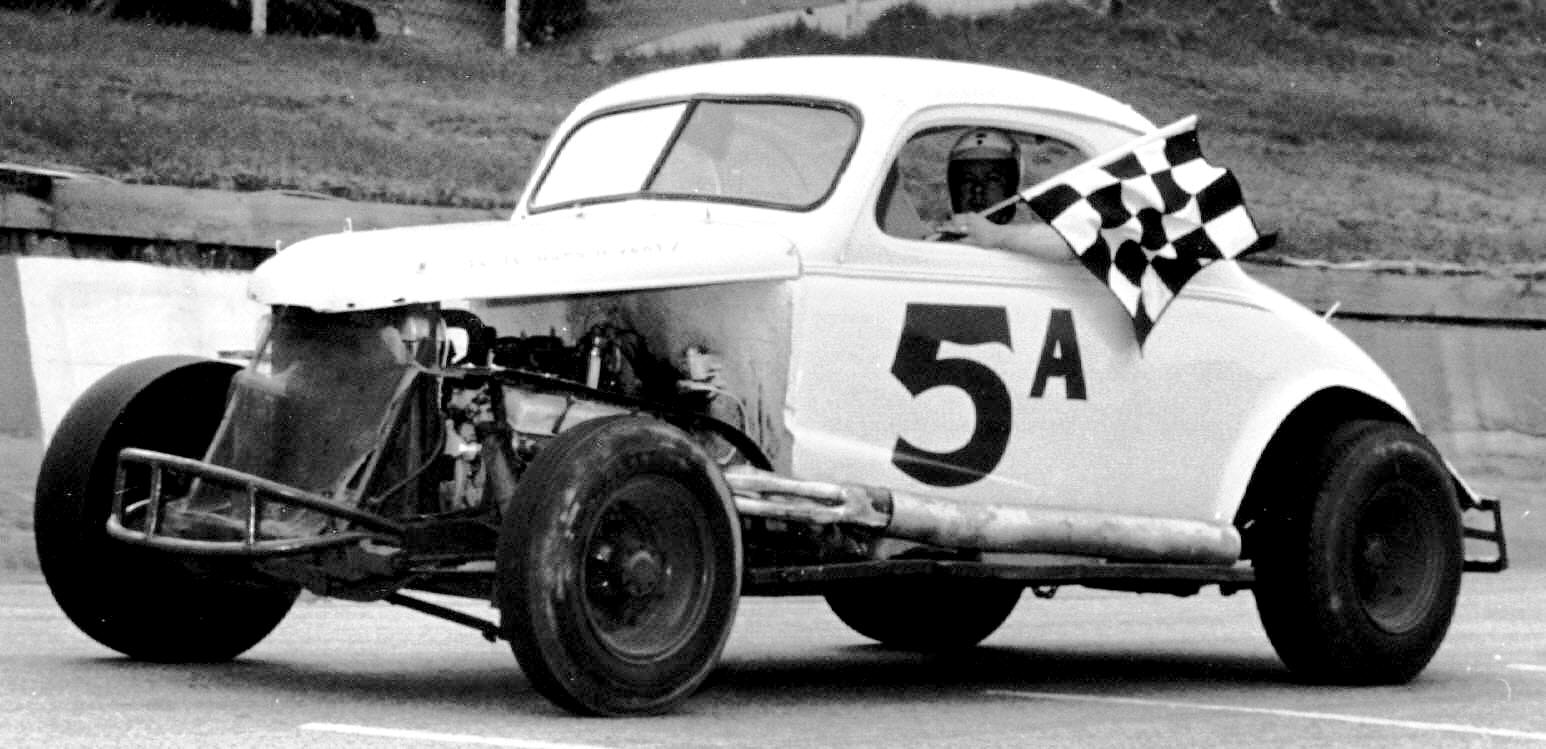

Courtesy of Cho Lee
Jean – Paul Cabana, with the
sportsman coupe he ran at Thunder Road and Catamount in 1965.
Right - The first 5A of Leon Hayford Below – The 5B, another coupe of
his, winning another T Road race.
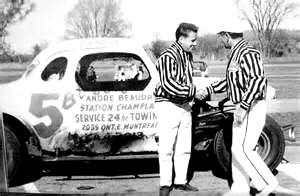
Courtesy of Cho Lee
Cabana, as well as drivers in his team car, began to make regular
appearances at Airborne Park Speedway in Plattsburgh, NY with other
Quebec stars such as Andre Manny and Marcel Godard. When Catamount
Stadium opened up in Milton, VT in 1965, Cabana won the first feature
there; and he and Manny fairly well dominated the place. After a brief
hiatus when Catamount went to exclusively hobby level Flying Tigers,
Cabana and his team raced there almost constantly, winning the track's
last race, too. By 1971, Cabana had set aside his coupes for a late
model sportsman Chevelle.
Although
a Thunder Road local driver named Leon Hayford had actually had the
number 5A before Cabana, the legendary Canadian is the one most
identified with that number. Stories began to circulate concerning how
he arrived at that number. The most popular and widely – accepted
theory was put forth by a young girl on some local broadcast when she
explained that “5A” came from the fact that there are five A's in Jean
– Paul Cabana. That was, more or less, the established explanation.

Courtesy of Cho Lee
Cabana could be quite a clown,
here posing with Milton policeman and sometimes - Catamount flagger,
Jack Paradee. Below –
The diminutive Cabana clowns around with Steve Poulin and Tiny Lund
before a race.
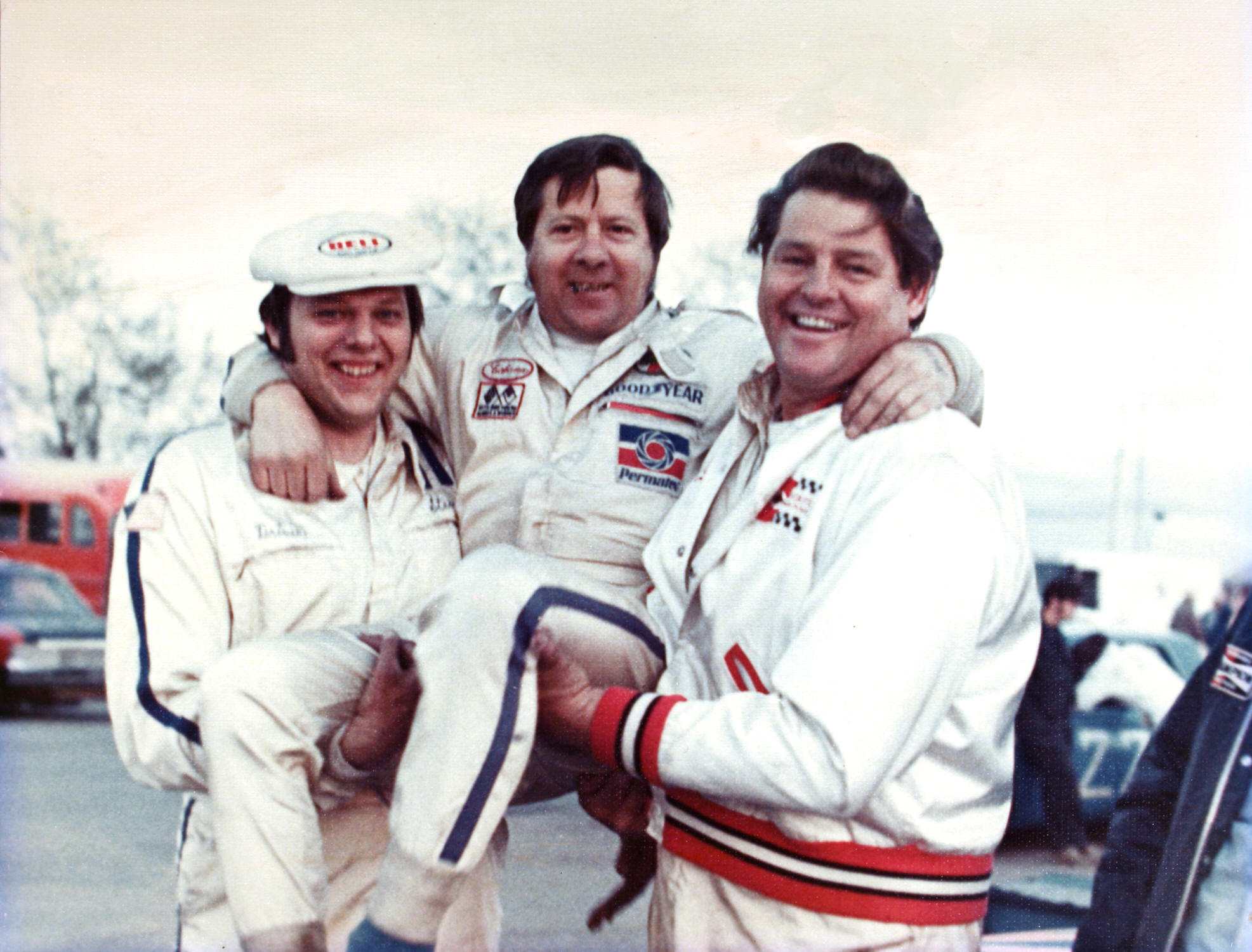
Courtesy of Steve Poulin
In
the summer of 2013, I was lucky enough to be invited to Dan Kearney's
camp on Lake Champlain for a reception featuring Bobby and Judy
Allison. One of the distinguished attendees there was Jean – Paul
Cabana and his close friend, Michel Circe. With most of the attention
focused on the Allisons, I got tons of quality time with JPC. One of
the questions I asked him was about the five A's story. He laughed at
the school girl story and thought it was creative; but he said it was
nothing that exotic. According to Jean – Paul, as his racing team
became more sophisticated [with a lot of help from Faniau] they were
fielding more than one car. Especially at Plattsburgh, it was
necessary for his car to be numbered 5A and the other to carry 5B,
often using driver Paul Hamel. That's all there was to it.
Another popular [and often well – financed driver was Quebec City's
Langis Caron. After showing up once at Catamount with a very
unremarkable Chevelle in 1972, Caron would reappear, sponsored to the
hilt in 1975 – supported by the huge LaBerge foundry near his home
town. Caron's first blue and maroon LaBerge car was a Chevelle; but
his best ride was a Nova, purchased down South and driven around 1977.
It is with this car and the converted school bus hauler he used that
our final myth arises.
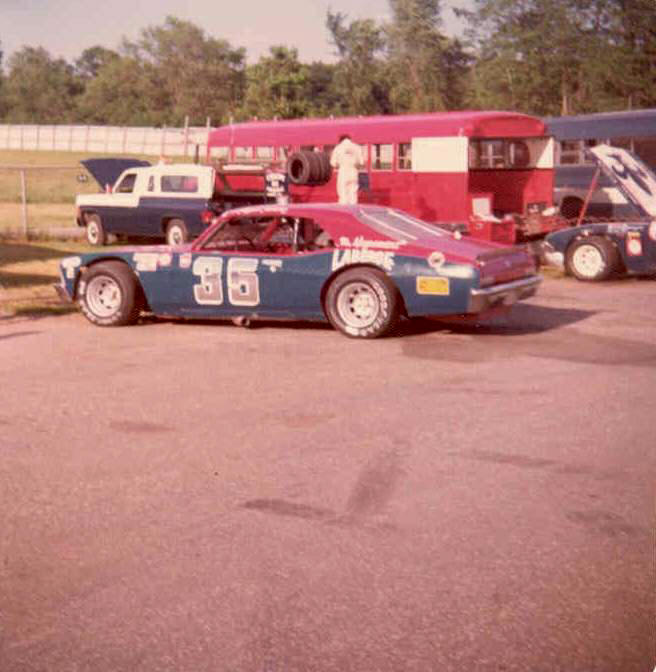
Courtesy of Claudy Lessard
The impressive LaBerge –
sponsored Langis Caron Nova sits in the Catamount pit area around
1977.
Below – The Caron hauler, with the nice roof modifications for doing
whatever up there.
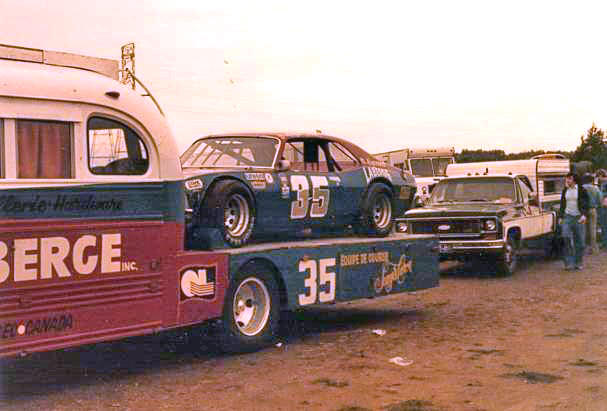
Courtesy of Pascal Cote's
Website
It
seems that, one particular hot, sticky Saturday night at Catamount,
practice sessions were going on as always. I don't know if they cycled
tires in those days like they do now, but many practice laps were
being put down. That early evening, for some unknown reason, an
inordinate number of cars were flying off turn one and spinning down
the hill from its high banks. This was beginning to aggravate track
management, as they were using that area for some posed photos.
Finally, the never – particularly – calm Tom Curley bellowed over the
track radios he wanted to know what the hell was going on. Was there
oil on the track ?
Whoever went out on the safety truck soon discovered the problem. One
of Caron's girlfriends was up on the roof of the hauler, sunbathing
topless. According to legend, Caron was sent up to admonish the girl
and get her the hell off the roof. When asked about this whole
incident, Caron will deny all of it, somewhat hotly. If he were more
nonchalant or detached, I would believe it more, but he gets pretty
irate. So....maybe. At any rate, we never saw anyone else atop the
Caron hauler unless they were very adequately clothed.
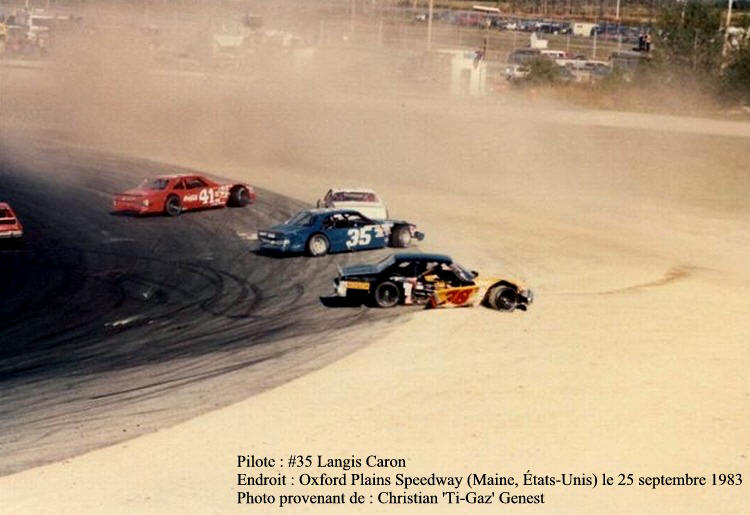
Christian Ti-Gaz Genest Photo
Cars including Langis fly off
the track at Oxford. Wait, where's Caron's hauler ?
Since this blog was first written another story in racing lore needs
to be corrected. This one's existence was mostly my doing. Anytone who
has read the Fonda Speedway history book knows of how Lou Lazarro got
started in racing – tied up with a bunch of Italian pals from Utica,
NY. The book shows Louie, still too young to drive himself, with
Junior Bianco [lifelong pal], Johnny Veletto, and Jan Manazzo
alongside this maroon and white race car with a 4 involved in the
number. All that bunch's cars were that color [for Proctor High
School, Utica] and they all had some variation with a 4 in it.
I
had a little shared chuckle with Lou once when I told him I also went
to the maroon and white of Proctor High School [only it was tiny
Proctor, VT]. The group raced some at places like Brookfield, Sharon,
and other tracks they could reach. Lou Lazarro, the younger insists
the cars were always Mopar coupes. I had come upon a photo of a winner
from one of the first races at Rutland VT's Pico Raceway in 1951. Same
colors, amn Italian looking driver, and a 4 in the number.
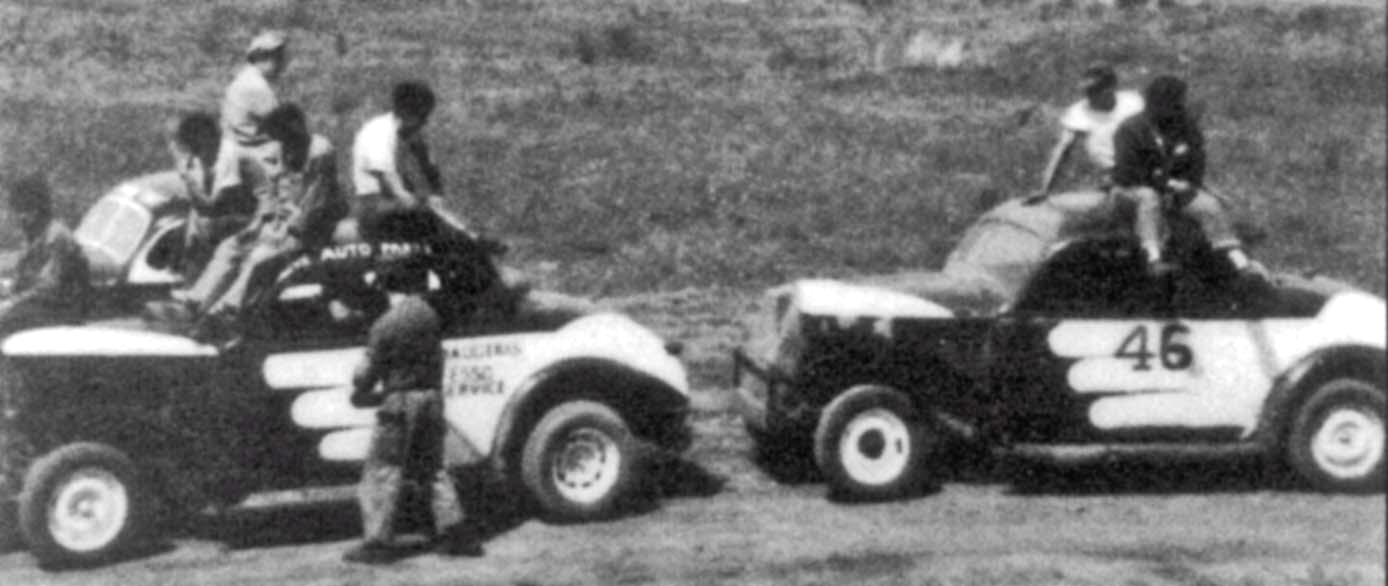
Peter Lazarro Collection via Fonda Book
The Utica bunch waits
for the races at Brookfield, NY in the early 1950's. Check out the
scheme on these cars.
Lou Lazarro is in the white shirt, on car 46. Below – This car was
involved in a wreck at Beech Ridge in the early '50's
– very similar scheme.
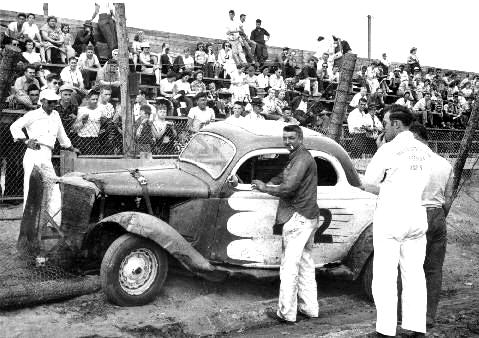
MVRCA Photo
Not long
after, I found a photo of another, similarly colored and numbered
coupe having had a wreck at Scarborough, ME's Beech Ridge Speedway
that same year. I assumed the Utica boys must have decided to have a
road trip. As it turns out, Lazarro the younger is extremely adamant
that there was no way those two cars in New England were Utica cars,
so I am officially backing off that theory. But, even Lou would have
to agree, if he saw the shots, the cars' color scheme, number style,
and build were eerily similar to the Utica cars [and the drivers both
looked Italian]. Oh well, consider that story dead.

Courtesy of the Lazarro Family
Lou Lazarro [right] with
his buddies in Utica around the first #4. Below - A very similar
looking car wins
a heat at Pico Raceway's opening day in 1951. But I think this one is
a Ford and Utica used Plymouths.

Rutland Herald Photo by Aldo Merusi
These
little stories, true, false, or just embellished – are what make the
sport what it used to be when it was zanier and more fun. Track
announcers try hard to develop some new characters today; but, hell,
the crowd at Thunder Road today doesn't even yell out drivers' names
at the introductions any more. Can you imagine that at Catamount, in
the fourth turn, in 1973 ?
Please email me if you have
any photos to lend me or information and corrections I could benefit from.
Please do not submit anything you are not willing to allow me to use on my
website - and thanks. Email is:
wladabou@comcast.net . For those who still don’t like computers - my
regular address is: Bill Ladabouche, 23 York Street, Swanton, Vermont 05488.















